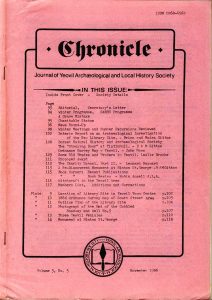1986-Nov-pg098_Winter Meetings Reviewed
This article came from the Chronicle published November 1986. Pages 93-94.
Winter Meetings – 1986
Author: Russ Clynick
7th March “INDUSTRIAL ARCHAEOLOGY OF LAND DRAINAGE IN SOMERSET”
Armed with a wealth of slides, Mr.Ian Miles described the very extensive system of rhines, or channels, cut over the centuries to solve the problems of periodic flooding of the Somerset Levels. The problems of the below sea level area are exacerbated by the confluence of five rivers – the Brue, Parrett, Isle, Tone and Yeo. In mediaeval times, the Abbots of Glastonbury made serious attempts to drain this very low-lying area. However, the Dissolution of the Monasteries in the 16th century led to much of this work being abandoned. Subsequent drainage work included the cutting of King’s Sedgemoor Drain, the Taunton to Bridgwater Canal and the deepening of the River Parrett. Sea walls were built along sections of Bridgwater Bay, to help eliminate periodic inundation. During the 18th and 19th centuries, a system of pumping stations was built along the banks of the rhines and canals. The early engines were eventually replaced by more powerful engines such as that at Weston Zoyland (See also report for 6th July 1986). Mr.Miles’ detailed and expert account was entertaining as well as instructive. He was thanked by Bill Chapman.
4th April “HALSTOCK ROMAN VILLA”
The 1986 Edgar Silcox Memorial Lecture was the occasion for Mr.Ron Lucas to give a full report on the Halstock Roman Villa complex. The dig began in 1967 and ended in 1985. It has been visited regularly by the Society and some members have assisted with the excavation. These were thanked by Mr.Lucas. He indicated that a full Report on the work will be ready for publication in about two years time but that it would be a very expensive undertaking and that he would appreciate any financial contribution the membership might make. A large number of slides of successive ground-plans and of the excavations helped to convey the development of this Romano-British settlement and place it in its context. The earliest feature on the site is a neolithic trackway, still in use as the muddy and narrow Long Lane. Evidence would seem to indicate the presence of an Iron Age farm below the Roman complex, the site being in continuous use for 300 to 400 years. A luxurious bath suite with mosaic floors and hypocaust was found in the early stages of the excavation. A range of farm buildings was also discovered with “T” shaped corn driers and an extensive water system, possibly indicative of fish farming. The many finds included nails, jewelry, arrow heads, counters and dice and one complete pot. The talk was received with rapt attention and the speaker was warmly thanked by Brian Gittos.
